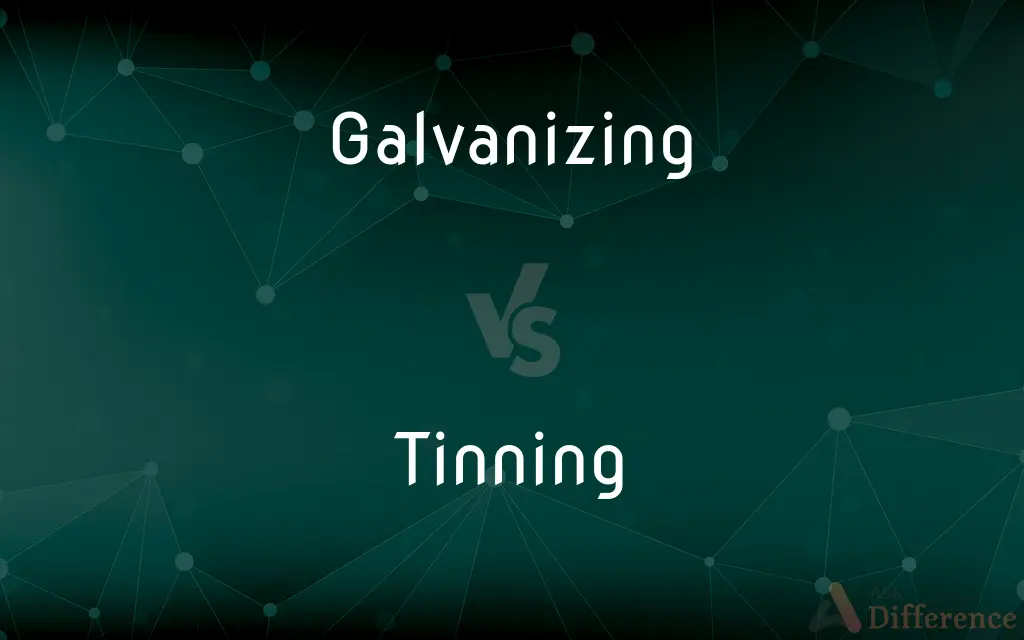Galvanizing vs. Tinning — What's the Difference?
Edited by Tayyaba Rehman — By Fiza Rafique — Published on October 5, 2023
Galvanizing involves coating steel or iron with zinc to prevent rusting, while Tinning means coating objects with a layer of tin, often for soldering or food safety.

Difference Between Galvanizing and Tinning
Table of Contents
ADVERTISEMENT
Key Differences
Galvanizing is a process mainly concerned with adding a protective zinc layer to steel or iron to prevent corrosion and enhance its durability. Tinning, on the other hand, involves the application of a tin layer to various metals.
Both Galvanizing and Tinning are forms of metal protection, but their application and purpose differ. For instance, galvanized metals are widely used in construction due to their resistance to rust, while tinned metals are common in the food industry and electronics due to the non-toxic nature of tin and its ability to conduct electricity.
Galvanizing, in general, offers a more robust resistance to environmental factors, particularly moisture, which causes rust in iron and steel. Tinning provides metals with a smoother finish, suitable for soldering and reducing the risk of contaminating food.
Both processes have been employed for centuries, showcasing humanity's ongoing effort to prolong the lifespan of metal products and enhance their utility.
Comparison Chart
Primary Metal Used
Zinc
Tin
ADVERTISEMENT
Main Purpose
Prevent rusting and corrosion in steel or iron
Food safety, soldering, electrical conductivity
Durability
Provides robust resistance to environmental factors
Might wear over time, especially with acidic foods
Commonly Treated Materials
Iron, steel
Copper, iron, steel
Appearance
Dull grey and rougher texture
Shiny and smooth
Compare with Definitions
Galvanizing
A method to prevent metal corrosion.
By galvanizing the metal sheets, they resisted rust effectively.
Tinning
Used for food containers due to tin's non-toxic nature.
Tinning the cans ensured food safety.
Galvanizing
Often used in the construction industry.
Galvanizing the beams increased the building's lifespan.
Tinning
The act of coating an object with a layer of tin.
Tinning the wire made it easier to solder.
Galvanizing
The process of coating iron or steel with zinc.
Galvanizing the fence ensured its longevity despite harsh weather.
Tinning
Aids in electrical conductivity.
Tinning the copper wire improved its electrical performance.
Galvanizing
Enhances outdoor metal durability.
Galvanizing was essential for the outdoor playground equipment.
Tinning
Enhances solderability of metals.
Tinning the connections ensured a secure bond during soldering.
Galvanizing
Provides a protective barrier against environmental factors.
Galvanizing the boat's components prevented seawater corrosion.
Tinning
Tinning is the process of thinly coating sheets of wrought iron or steel with tin, and the resulting product is known as tinplate. The term is also widely used for the different process of coating a metal with solder before soldering.It is most often used to prevent rust, but is also commonly applied to the ends of stranded wire used as electrical conductors to prevent oxidation (which increases electrical resistance), and to keep them from fraying or unraveling when used in various wire connectors like twist-ons, binding posts, or terminal blocks, where stray strands can cause a short circuit.
Galvanizing
To stimulate or shock with an electric current.
Tinning
Symbol Sn A crystalline, silvery metallic element obtained chiefly from cassiterite, and having two notable allotropic forms. Malleable white tin is the useful allotrope, but at temperatures below 13.2°C it slowly converts to the brittle gray allotrope. Tin is used to coat other metals to prevent corrosion and is a part of numerous alloys, such as soft solder, pewter, type metal, and bronze. Atomic number 50; atomic weight 118.71; melting point 231.93°C; boiling point 2,602°C; specific gravity (gray) 5.77, (white) 7.29; valence 2, 4. See Periodic Table.
Galvanizing
To arouse to awareness or action; spur
"The country was galvanized in the weeks and months after 9/11" (Davis Phinney).
Tinning
Tin plate.
Galvanizing
To coat (iron or steel) with rust-resistant zinc.
Tinning
A container or box made of tin plate.
Galvanizing
Present participle of galvanize
Tinning
A container for preserved foodstuffs; a can.
Galvanizing
The process by which something is galvanized.
Tinning
The contents of such a container.
Galvanizing
Affected by emotion as if by electricity; thrilling;
Gave an electric reading of the play
The new leader had a galvanic effect on morale
Tinning
To plate or coat with tin.
Tinning
Chiefly British To preserve or pack in tins; can.
Tinning
Of, relating to, or made of tin.
Tinning
Constructed of inferior material.
Tinning
Spurious.
Tinning
Present participle of tin
Tinning
A covering or lining of tin.
Tinning
The act, art, or process of covering or coating anything with melted tin, or with tin foil, as kitchen utensils, locks, and the like.
Tinning
The covering or lining of tin thus put on.
Tinning
The application of a thin layer of soft solder to the ends of wires before soldering them;
Careful tinning of the ends of wires results in a better joint when you solder them
Tinning
The application of a protective layer of tin
Tinning
Provides a smooth finish to metals.
The tinning process gave the metal sheets a sleek appearance.
Common Curiosities
What is Tinning?
Tinning is the act of coating a metal, often copper or iron, with a layer of tin.
What is Galvanizing?
Galvanizing is the process of coating steel or iron with zinc to prevent rusting.
Why is Galvanizing important?
Galvanizing prevents metal corrosion, enhancing its durability and lifespan.
In which industry is Tinning predominantly used?
Tinning is widely used in the food industry for cans and in electronics for soldering.
Is Tinning safe for food storage?
Yes, tin is non-toxic, making tinned containers suitable for food storage.
Can Galvanizing wear off?
Over time and with exposure, the zinc in galvanizing can gradually wear away, but it generally offers prolonged protection.
Why is Tinning used for soldering?
Tinning provides a smooth surface, making soldering easier and more effective.
Does Galvanizing change the appearance of metals?
Yes, galvanizing gives metals a dull grey and slightly rough texture.
What metals are commonly galvanized?
Iron and steel are the primary metals subjected to galvanizing.
What metals are commonly tinned?
Copper, iron, and steel are often tinned.
Share Your Discovery

Previous Comparison
Error Of Omission vs. Error Of Commission
Next Comparison
Pen Drive vs. USB DriveAuthor Spotlight
Written by
Fiza RafiqueFiza Rafique is a skilled content writer at AskDifference.com, where she meticulously refines and enhances written pieces. Drawing from her vast editorial expertise, Fiza ensures clarity, accuracy, and precision in every article. Passionate about language, she continually seeks to elevate the quality of content for readers worldwide.
Edited by
Tayyaba RehmanTayyaba Rehman is a distinguished writer, currently serving as a primary contributor to askdifference.com. As a researcher in semantics and etymology, Tayyaba's passion for the complexity of languages and their distinctions has found a perfect home on the platform. Tayyaba delves into the intricacies of language, distinguishing between commonly confused words and phrases, thereby providing clarity for readers worldwide.














































